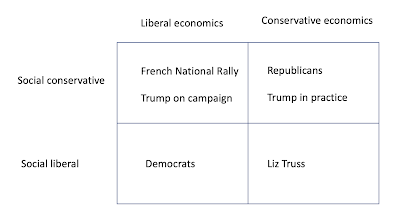Earlier this year, I
had a post about a survey of college students on free speech issues. Students at more selective universities (measured by the admissions rate) were more willing to accept controversial speakers. I suggested two possible explanations: "it could be because they are more liberal, and liberals tend to be more favorable to the principle of free speech, or because they are more intellectually sophisticated, and more intellectually sophisticated people are more favorable to the principle (or some mix of both)." I couldn't test those ideas, because I didn't have information about ideology. However, there's an updated version of the survey, and I obtained a copy of the data from the sponsor (the Foundation for Individual Rights and Expression). That contains a question about ideology (very conservative to very liberal, plus options for "haven't thought about this" and other), making it possible to see how it is related to tolerance for speakers.
The hypothetical speakers include four right wing examples--abortion should be completely illegal, Black Lives Matter is a hate group, the 2020 election was stolen, and transgender people have a mental disorder--and four left-wing examples: the 2nd Amendment should be repealed so that guns can be confiscated, undocumented immigrants should be given the right to vote, white people are collectively responsible for structural racism and use it to protect their privilege, and religious liberty is used as an excuse to discriminate against gays and lesbians. For each one, respondents were asked if the speaker definitely should be, probably should be, probably should not be, or definitely should not be allowed.
Here is the relationship between admission rate and tolerance of the two types of speakers:
The figures for left-wing speakers are in red and those for right-wing speakers are in blude. I indicate a few universities and colleges by name: Chicago, which is among the most tolerant of both; Hillsdale, which is by far the most tolerant of right-wing speakers; Smith, which is the least tolerant of right wing speakers; and Wyoming, which is the least tolerant of left-wing speakers. One point that stands out is that there is less tolerance of right-wing speakers--in fact, only one of about 200 colleges surveyed (Hillsdale) is more tolerant of right-wing than of left-wing speakers. Of course, the examples can't be exactly parallel, so you could argue that in some sense the right-wing ones are more extreme. But the same gap, with about the same magnitude, appeared in the previous survey.
Moving on to the relationship with selectivity, more selective places are clearly more tolerant of left-wing speakers. They are slightly less tolerant of right-wing speakers, although it seems like the relationship may be non-monotonic, with the lowest tolerance occurring at moderately selective schools (those that accept about 30% of applicants).
If you add tolerance of left and right-wing speakers together, more selective schools are more tolerant:
It seems to be a non-linear relationship, with little difference from about 30-100% and rising as the admission rate goes toward zero. If you regress overall tolerance on the admission rate, the t-ratio is about 6; if you regress it on the inverse of the admission rate, the t-ratio is about 7.6.
What about ideology? More selective schools are more liberal:
The average ideology (weighting the schools equally) is 3.0, which is more liberal than the general public aged 18-23 (3.7 in 2021, according to the GSS, which has an almost identical question on ideology). Among the most selective (admission rate of less than 20%), 26% say they are very liberal, 39% somewhat or slightly liberal, 11% moderate, 12% slightly, somewhat, or very conservative, with 3% no opinion and 7% other. But even at the least selective, they generally lean to the left: at those with admission rates of 80-100%, 44% are some variety of liberal, 16% moderate, and 26% some variety of conservative.
What about the relationship between ideology and tolerance?
I also include the people who didn't place themselves on the liberal-conservative scale. People who said that they were neither liberal nor conservative were asked a follow-up question giving three options: democratic socialist, libertarian, and other. Within the liberal to conservative categories, there is a tendency for conservatives to be more tolerant. But the people who said they "haven't thought about it" are the least tolerant. As I said before, tolerance isn't a natural state--it's something that people need to be persuaded to accept.
One of my hypotheses about the relationship between selectivity and tolerance--that it results from ideological differences--is refuted. The survey doesn't contain any question that could reasonably be regarded as a measure of intellectual sophistication. However, while there are certainly individual exceptions, it seems safe to say that on the average students at more selective universities are more intellectually sophisticated than those at less selective ones. So the other hypothesis--that intellectually sophisticated people are more tolerant--is consistent with the data.
I found a number of other interesting things in the data, so I will return to it in a later post, after I get to a few other things which I've been meaning to write about.
[Thanks to the Foundation for Individual Rights and Expression for providing the data]
















